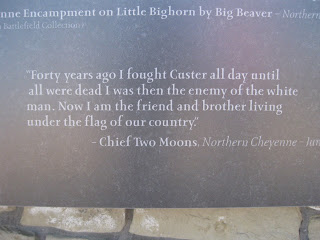


Throughout most of our history since the Battle of the Little Big Horn in 1876, little recognition was given to the "other side" in this battle, the native Americans who fought bravely in defense of their way of life. In December 1991 the official name of the battlefield was changed from Custer Battlefield National Monument to Little Bighorn Battlefield National Monument.
The Indian Memorial near Last Stand Hill was dedicated June 25, 2003, as part of a movement to bring a more balanced perspective to the Battle of the Little Bighorn. "Peace Through Unity" became the battlefield theme.
Reports from survivors on both sides of the battle indicate that their opponents fought bravely and well. The placement of Warrior Markers, made from red granite, was initiated in 1999, to mark locations where Indian warriors fell. Identifying warrior death sites is more difficult because their bodies were removed following the battle. Park Service experts are working with the various tribes to determine the number and death location of native American casualties. While the exact number of Indian losses is unknown, historians estimate that there were 60 to 100 killed.
The native American encampment on the Little Bighorn River prior to the battle was estimated to include up to 7000 men, women, and children; and scouts estimated that the encampment may have included a herd of horses running into the thousands. Scouts from the Seventh Cavalry spotted the encampment from a lookout point approximately 14 miles to the east as they approached. The first concrete evidence of a large encampment was the very large herd of horses. Custer's intention was to surround this large encampment before they could disperse.
A national contest was held to design an Indian Memorial on the battlefield site. The first picture is from a granite marker in the Memorial. The message of Chief Two Moons, one of the Northern Cheyenne leaders in the battle, reflects the new spirit of the battlefield: "Forty years ago I fought Custer all day until all were dead. I was then the enemy of the white man. Now I am the friend and brother living under the flag of our country."
The second photo shows the Spirit Warriors Sculpture on the Memorial. The final picture shows a section of the circular memorial with marble panels commemorating each of the native American tribes involved in the battle.
No comments:
Post a Comment